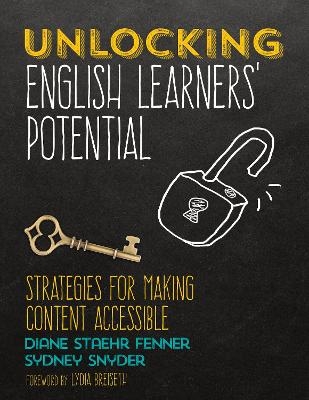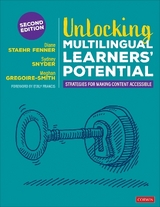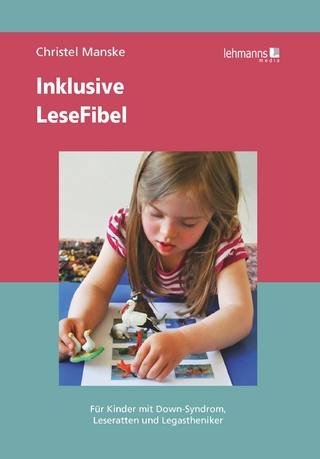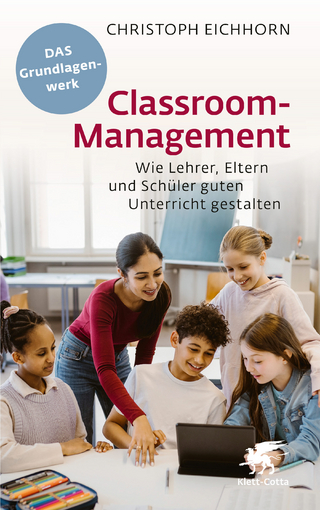
Unlocking English Learners′ Potential
Corwin Press Inc (Verlag)
978-1-5063-5277-0 (ISBN)
- Titel erscheint in neuer Auflage
- Artikel merken
A once-in-a-generation text for assisting a new generation of students
Content teachers and ESOL teachers, take special note: if you’re looking for a single resource to help your English learners meet the same challenging content standards as their English-proficient peers, your search is complete. Just dip into this toolbox of strategies, examples, templates, and activities from EL authorities Diane Staehr Fenner and Sydney Snyder. The best part? Unlocking English Learners’ Potential supports teachers across all levels of experience.
The question is not if English learners can succeed in today’s more rigorous classrooms, but how. Unlocking English Learners’ Potential is all about the how:
How to scaffold ELs’ instruction across content and grade levels
How to promote ELs’ oral language development and academic language
How to help ELs analyze text through close reading and text-dependent questions
How to build ELs’ background knowledge
How to design and use formative assessment with ELs
Along the way, you’ll build the collaboration, advocacy, and leadership skills that we all need if we’re to fully support our English learners. After all, any one of us with at least one student acquiring English is now a teacher of ELs.
"Schools are not intentionally equitable places for English learners to achieve, but they could be if the right system of support were put in place. Diane Staehr Fenner and Sydney Snyder recommend just such a system. Not only does it have significant potential for providing fuller access to the core curriculum, it also provides a path for teachers to travel as they navigate the individual needs of students and support their learning journeys."
—Douglas Fisher, Coauthor of Visible Learning for Literacy
Diane Staehr Fenner, PhD, is the president of SupportEd (SupportEd.com), a woman-owned small business located in the Washington, DC, metro area that she founded in 2011. SupportEd is dedicated to empowering multilingual learners and their educators. Dr. Staehr Fenner leads her team to provide ML professional development, coaching, technical assistance, and curriculum and assessment support to school districts, states, organizations, and the U.S. Department of Education. Prior to forming SupportEd, Dr. Staehr Fenner was an English language development (ELD) teacher, dual language assessment teacher, and ELD assessment specialist in Fairfax County Public Schools, VA. She speaks German and Spanish and has taught in Berlin, Germany, and Veracruz, Mexico. Dr. Staehr Fenner grew up on a dairy farm in central New York and is a proud first- generation college graduate. She has written eight books on ML education (and counting), including coauthoring Culturally Responsive Teaching for Multilingual Learners: Tools for Equity and authoring Advocating for English Learners: A Guide for Educators. She is a frequent keynote speaker on ML education at conferences across North America. She earned her PhD in Multilingual/Multicultural Education at George Mason University and her MAT in TESOL at the School for International Training. You can connect with her by email at Diane@SupportEd.com or on Twitter at @DStaehrFenner. Sydney Snyder, PhD, is a principal associate at SupportEd. In this role, Dr. Snyder coaches ML educators and develops and facilitates interactive professional development for teachers of MLs. She also works with the SupportEd team to offer technical assistance to school districts and educational organizations. Dr. Snyder has extensive instructional experience and has worked in the field of English language development for over 25 years. She started her teaching career as a Peace Corps volunteer in Guinea, West Africa. This experience ignited her passion for language teaching, culturally responsive instruction, and ML advocacy. Dr. Snyder is coauthor of Culturally Responsive Teaching for Multilingual Learners: Tools for Equity and contributing author to Breaking Down the Monolingual Wall. She served as an English Teaching Fellow at Gadja Mada University in Yogyakarta, Indonesia. She earned her PhD in Multilingual/ Multicultural Education at George Mason University and her MAT in TESOL at the School for International Training. You can connect with her by email at Sydney@SupportEd.com or on Twitter at @SydneySupportEd.
Foreword
Acknowledgments
About the Authors
Introduction
Chapter 1: Why You Need This Book to Support ELs
What Is the Framework for Equitable and Excellent EL Education?
What Is the Sense of Urgency Around ELs’ Equitable and Excellent Learning?
How Are ELs’ Demographics Changing?
What Are ELs’ Opportunity and Achievement Gaps?
What Shifts Have Occurred in Content Standards, and How Do These Affect ELs?
What Are the Guiding Principles That We Use to Frame Our Work With ELs and This Book?
How Do I Get Started Using All Five Guiding Principles?
Conclusion
Reflection Questions
References
Chapter 2: Using a Culturally Responsive Framework to Meet the Needs of ELs
What Is Culture?
Why Does Culture Matter for ELs’ Teaching and Learning?
How Can I Begin to Understand How My Cultural Expectations May Differ From Those of My ELs and the Impact This Will Have in the Classroom?
What Is Culturally Responsive Pedagogy?
What Are the Guidelines of Culturally Responsive Teaching?
What Is the Role of Collaboration in Developing a Culturally Responsive Classroom?
What Is the Role of Equity, Advocacy, and Leadership in Developing a Culturally Responsive Classroom?
Next Steps
Conclusion
Reflection Questions
References
Additional Resources
Chapter 3: Scaffolding Instruction for ELs
What Is a Scaffold?
What Are Different Types of Scaffolds?
What Types of Materials and Resources Can I Use to Scaffold Instruction?
What Instructional Practices Can I Use as Scaffolding?
How Can I Use Student Grouping to Scaffold Instruction?
What Steps Should I Take to Scaffold a Lesson?
Steps for Developing Scaffolded Lessons Plans
How Do I Select the Most Appropriate Scaffold for a Task for Each Modality of Language?
What Is the Role of Collaboration in Scaffolding Instruction for ELs?
What Is the Role of Equity, Advocacy, and Leadership in Developing Scaffolded Materials?
Conclusion
Application Activity Responses
Reflection Questions
References
Additional Resources
Chapter 4: Academic Conversations: A Tool for Fostering ELs’ Oral Language Development
Why Is It Important to Focus on ELs’ Oral Language Development?
How Do I Develop Effective Oral Language Activities for ELs?
What Practices Can ELs Engage in to Support Their Participation and Engagement in Oral Language Activities?
What Are Some Activities for Supporting ELs’ Oral Language Development?
How Can I Collaborate Around ELs’ Academic Conversations?
What Is the Role of Equity, Advocacy, and Leadership in Supporting ELs’ Oral Language Development?
Next Steps
Conclusion
Reflection Questions
References
Chapter 5: Teaching Academic Language to ELs
What Is Academic Language?
How Is Academic Language Different From Social Language?
How Is Academic Language Structured?
What Is the Interplay Between Scaffolds, Errors, and Academic Language?
What Is the Word Level?
What Is the Sentence Level?
What Is the Discourse Level?
Why Is Academic Language Important?
Why Don’t ELs Just Need Assistance With Vocabulary?
What Does It Mean That Acquisition of Academic Language Takes Place Within a Sociocultural Context?
How Do I Increase My Awareness of the Academic Language ELs Need to Access Challenging Content?
How Can I Figure Out What Academic Language Might Be Challenging for My ELs?
How Do I Teach Sentence-Level Academic Language to ELs?
How Do I Teach Discourse-Level Academic Language to ELs?
What Steps Should I Follow When Planning Instruction That Integrates Instruction of Academic Language Simultaneously With Content?
How Can I Coplan Instruction of Academic Language When My Time Is Limited?
How Can I Infuse Equity, Advocacy, and Leadership to Promote Academic Language?
Next Steps
Conclusion
Reflection Questions
References
Chapter 6: Vocabulary Instruction and ELs
What Is Academic Vocabulary?
Why Teach Academic Vocabulary to ELs?
How Should I Select Vocabulary for In-Depth Instruction?
How Can I Assess Students’ Initial Understanding of These New Words?
What Strategies Should I Use for Teaching Academic Vocabulary?
What Activities Can I Use to Help My ELs Practice New Vocabulary?
How Can I Help My ELs Become Independent Learners of New Vocabulary?
How Do I Put All of the EL Vocabulary Strategies Together?
What Is the Role of Collaboration in Teaching Academic Vocabulary to ELs?
What Is the Role of Equity, Advocacy, and Leadership in Teaching Academic Vocabulary to ELs?
Next Steps
Conclusion
Reflection Questions
References
Additional Tools and Resources
Chapter 7: Teaching ELs Background Knowledge
Reflection: How Do I Feel About Teaching Background Knowledge to ELs?
How Can I Raise My Awareness About the Importance of ELs’ Background Knowledge?
What Does the Research Say About Background Knowledge?
What Is the Close Reading of Texts?
What Is the Role of Background Knowledge in ELs’ Close Reading of Texts?
How Do I Match ELs to Texts?
What Is a Framework I Can Use for Building ELs’ Background Knowledge?
Step 1: How Do I Find out My ELs’ Prior Knowledge on a Particular Topic or Text?
Step 2: How Do I Decide How Much Background Knowledge to Provide to ELs?
Step 3: How Do I Activate ELs’ Background Knowledge That They Already Possess?
Step 4: What Are Some Strategies for Concisely Teaching ELs Background Knowledge?
What Are Some Examples of Teaching Background Knowledge?
How Can I Apply the Four-Step Framework When Teaching Background Knowledge to ELs?
How Do I Build or Activate ELs’ Background Knowledge in Mathematics?
How Do I Construct Less Biased Mathematics Problems for ELs?
What Is the Role of Collaboration in Teaching Background Knowledge?
What Is the Role of Equity, Advocacy, and Leadership in Teaching Background Knowledge?
Conclusion
Reflection Questions
Application Activity Responses
References
Chapter 8: Supporting ELs’ Reading for Multiple Purposes Through Using Scaffolded Text-Dependent Questions
What Does It Mean to Read for Multiple Purposes?
How Can I Specifically Scaffold My Instruction of ELs to Support Their Reading for Multiple Purposes?
What Are TDQs?
What Type of Questions Should I Ask to Create TDQs for ELs?
How Do I Scaffold My ELs’ Responses to TDQs?
What Steps Should I Take to Create TDQs for ELs?
How Do I Apply What I Have Learned About Creating TDQs for ELs?
How Do I Collaborate to Create Effective Scaffolded TDQs for ELs?
What is the Role of Equity, Advocacy, and Leadership in Creating TDQs?
Conclusion
Reflection Questions
Application Activity Responses
References
Chapter 9: Formative Assessment for ELs
What Is Assessment as, of, and for Learning?
What Is Formative Assessment?
What Does the Research Say on Assessment for ELs in General?
What Is the Role of Formative Assessment With ELs?
How Do I Structure the Formative-Assessment Process for ELs?
How Can I Interpret Formative-Assessment Evidence to Inform Instruction of ELs?
What Is Assessment Validity for ELs, and How Can I Ensure My Formative Assessments Are Valid?
How Can I Ensure That Formative Assessments Are Valid for ELs of Varying Proficiency Levels?
How Do I Scaffold Formative Assessments for ELs?
How Does the Formative-Assessment Process for ELs Unfold in a Classroom?
How Can I Support My ELs on Computer-Based Formative Assessments?
What Is the Role of Collaboration in Creating and Using Formative Assessments for ELs?
What Is the Role of Equity, Advocacy, and Leadership in Creating and Using Formative Assessments for ELs?
What Are the Next Steps to Design Formative Assessments Specific to My Context?
Conclusion
Reflection Questions
References
Index
| Erscheinungsdatum | 06.06.2017 |
|---|---|
| Verlagsort | Thousand Oaks |
| Sprache | englisch |
| Maße | 215 x 279 mm |
| Gewicht | 790 g |
| Themenwelt | Sozialwissenschaften ► Pädagogik ► Schulpädagogik / Grundschule |
| ISBN-10 | 1-5063-5277-4 / 1506352774 |
| ISBN-13 | 978-1-5063-5277-0 / 9781506352770 |
| Zustand | Neuware |
| Informationen gemäß Produktsicherheitsverordnung (GPSR) | |
| Haben Sie eine Frage zum Produkt? |
aus dem Bereich



